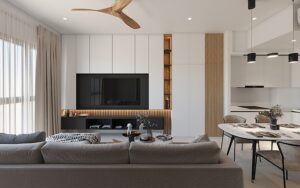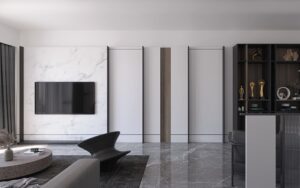Transforming a household into a contemporary, fashionable, and practical living space is art and technological know-how. Modern interior design goes beyond mere aesthetics and focuses on growing environments that reflect the personalities of the occupants while optimizing comfort and software. This approach integrates ultra-modern design trends with timeless principles to make certain spaces not only cutting-edge but also sustainable and harmonious.
The essence of modern interior design lies in its ability to seamlessly combine shapes and features. It emphasizes light footprints, minimalist decor, and a palette that favors clutter. By prioritizing space optimization and personalization, this design philosophy transforms houses into sanctuaries that support everyday life in the most green and aesthetically fascinating way.
Each step to transform your home with modern interior design is designed to encourage homeowners to redefine their living space and ensure that every corner is customized to meet their unique desires and capabilities.
1. Embrace Minimalism
What is Minimalism?
Minimalism is more than just a design style; it is a way of life that promotes simplicity and the concept of “less is more”. In contemporary interior design, minimalism involves reducing waste and focusing on the essentials to create a clean, open, and uncluttered space. But how can you get it?
The Benefits of Minimalism
- Stress reduction: An open space can help reduce tension and promote calmness. Have you noticed how a tidy room can instantly lift your mood?
- Improved Aesthetics: Minimalist areas are visually appealing, providing a sense of calm and an area that is regularly confused in extra crowded designs.
- Easier Maintenance: Fewer tools means less cleaning and maintenance, saving you more time to enjoy in your own home.
2. Invest in Quality, not Quantity
Quality Over Quantity
Why fill your home with a lot of mediocre gadgets when some extremely good portions could make a stronger statement? Investing in nice furniture and decorations now is not the easiest to improve the appearance of your private home, but it will also prove to be financially smart in the long run.
Selection of Key Parts
- Research before you buy: Take the time to find furniture that is properly made and durable. A solid wooden dining table or a quality leather sofa can be closed for years and will never go out of style.
- Focus on the Essentials: Identify the important things you want the most and put money into them. For example, a comfortable and excellent mattress frame is essential for the bedroom.
- Comfort test: Always check comfort, especially when sitting. Remember that what looks exactly must additionally make sense.
3. Incorporate Natural Elements
Why Biophilic Design?
The biophilic design is set to bring the outdoors inside and connect with nature from the comfort of your home. This approach has been proven to improve health, enhance creativity, and increase well-being. But how to incorporate these factors into your private home without any problems?
Use of Plants and Natural Materials
- Add plants: From a huge potted tree in a sunny corner to small succulents on shelves, vegetation can bring life to any room.
- Choose natural materials: Opt for furniture and finishes made from plant-based materials such as wood, stone, rattan, and cotton. A wooden coffee table or a stone coaster can add a touch of nature.
- Maximize Natural Light: Use large home windows, sheer curtains, and strategically placed mirrors to add extra herbal light to your home.
4. Play with Light and Shadow
The Importance of Lighting
Lighting is one of the most important elements of modern interior design. It can change the mood of a room, making it feel relaxed and intimate or brilliant and lively. What are exceptional approaches to using lighting to transform your area?
Types of Lighting
- Ambient Lighting: This is your predominant light source – both herbal and through fixtures like chandeliers. It sets the overall tone of the room.
- Task lighting: These are lights designed for unique tasks such as reading or cooking. For example, under-cabinet lighting in the kitchen can make food preparation easier.
- Accent Lighting: Used to focus on key features such as artistic or architectural features, accent lights add drama to a space.
5. Focus on Color and Texture
The Power of Color
Did you know that colors can greatly affect our mood and perception of space? The right color palette can energize a room or transform it into a calming sanctuary. But how to choose the right shades for your modern interior?
Choosing a Modern Palette
- Neutral tones: Start with neutral tones like white, gray, and beige as a base. These shades are timeless and will make your rooms look bigger and brighter.
- Bold Accents: Add pops of color with accents in bolder sunglasses. How about a bright blue pillow or a rich green plant? These elements carry electricity and focal factors into your space.
- Warm vs. Cold: Decide on the overall temperature. Warm tones like red and orange create coziness, just as cool tones like blue and green evoke calmness.

6. Optimize Space with Smart Layouts
Effective Space Planning
How can you make the most of every square inch? Effective space planning is key to improving flow and functionality in your home. Here are some strategies to remember:
Multipurpose Furniture
- Storage solutions: Look for furniture that doubles as storage. An ottoman with hidden space or a bed with drawers can reduce clutter.
- Versatile pieces: Invest in pieces that can serve multiple purposes. A notable example is a sofa bed or a dining table that can expand for visitors.
- Space savers: Use wall cabinets and organizers to free up floor space.
Visual Tricks
Sometimes it is important to make the experience of the room bigger, in optical illusions:
- Mirrors: Place mirrors strategically to reflect mild and create the illusion of a larger area. A massive reflection unlike a window can dramatically open up a room.
- Transparent furniture: Objects such as glass tables and acrylic chairs maintain uninterrupted lines of sight and increase distance.
- Vertical lines: Use tall, slender pieces of furniture and vertical footprints to draw attention upwards to make the room appear taller.
7. Customize your Space
Express your Style
Your home should inform your story. How can you bring your personality to your living space?
Personal Touches
- Art and Photography: Display artwork that speaks to you or photos of you that bring back fond memories. These private objects will add character and warmth to your home.
- Unique Items: Include items that replicate your pastimes or travels. A handmade vase or antique rug can work as a statement piece to showcase your style.
- Color Selection: Use your favorite hues in accents to make the distance certainly your own.
DIY Projects
Getting involved in DIY initiatives can be a fun way to personalize your area:
- Custom decorations: Try developing your wall art or upcycling old light fixtures.
- Handmade accessories: Knit or stitch some fabric pillow covers to complement your decor.
- Personalized Storage: Build or upgrade garage bins that shape your interior and keep your possessions organized.
Conclusion
Transforming your own home with modern interior design does not require a complete redesign. By embracing minimalism, investing in uniqueness, incorporating herbal elements, optimizing lighting that specializes in color and texture, planning smart layouts, and personalizing your space, you can create a home that is both stylish and deeply private.
